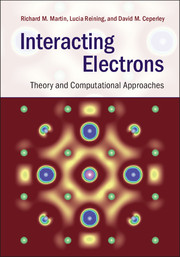Book contents
- Frontmatter
- Dedication
- Contents
- Preface
- Acknowledgments
- Notation
- Part I Interacting electrons: beyond the independent-particle picture
- Part II Foundations of theory for many-body systems
- Part III Many-body Green's function methods
- 9 Many-body perturbation theory: expansion in the interaction
- 10 Many-body perturbation theory via functional derivatives
- 11 The RPA and the GW approximation for the self-energy
- 12 GWA calculations in practice
- 13 GWA calculations: illustrative results
- 14 RPA and beyond: the Bethe–Salpeter equation
- 15 Beyond the GW approximation
- 16 Dynamical mean-field theory
- 17 Beyond the single-site approximation in DMFT
- 18 Solvers for embedded systems
- 19 Characteristic hamiltonians for solids with d and f states
- 20 Examples of calculations for solids with d and f states
- 21 Combining Green's functions approaches: an outlook
- Part IV Stochastic methods
- Part V Appendices
- References
- Index
13 - GWA calculations: illustrative results
from Part III - Many-body Green's function methods
Published online by Cambridge University Press: 05 June 2016
- Frontmatter
- Dedication
- Contents
- Preface
- Acknowledgments
- Notation
- Part I Interacting electrons: beyond the independent-particle picture
- Part II Foundations of theory for many-body systems
- Part III Many-body Green's function methods
- 9 Many-body perturbation theory: expansion in the interaction
- 10 Many-body perturbation theory via functional derivatives
- 11 The RPA and the GW approximation for the self-energy
- 12 GWA calculations in practice
- 13 GWA calculations: illustrative results
- 14 RPA and beyond: the Bethe–Salpeter equation
- 15 Beyond the GW approximation
- 16 Dynamical mean-field theory
- 17 Beyond the single-site approximation in DMFT
- 18 Solvers for embedded systems
- 19 Characteristic hamiltonians for solids with d and f states
- 20 Examples of calculations for solids with d and f states
- 21 Combining Green's functions approaches: an outlook
- Part IV Stochastic methods
- Part V Appendices
- References
- Index
Summary
Summary
The present chapter illustrates what the GWA can do and what it cannot do. It contains results for metals, semiconductors, and insulators, for bulk materials and low-dimensional systems, for materials that reflect features of the homogeneous electron gas and for others that present completely different aspects. It shows the physical soundness and broadness of the approach in a wide range of applications, and in others the need to go beyond.
The GW approximation to the self-energy is a surprisingly simple formula, with a clear physical content as discussed in Ch. 11, and the potential for efficient calculations of electronic properties beyond independent-particle methods as described in Ch. 12. It is now time to look at results for realistic systems and ask: which properties can be described successfully by the GWA, and for which materials? And what can we learn from the results?
The selection presented in this chapter covers only a fraction of what could be cited. The GWA has become a very popular method – for valuable reasons, as the chapter shows: having a good approximation to the self-energy allows one to calculate accurate band structures, electron addition and removal spectra, densities, density matrices, total energies, and many related properties. GWA calculations lead to qualitative and often quantitative agreement with experimental findings. There exist many more applications, but here we have selected examples meant to illustrate content, strong and weak points of the GWA, in its various flavors such as perturbative or non-perturbative calculations. The examples are chosen to stress certain aspects, and they are not necessarily the first or the most recent calculations. A time span of several decades is covered. As a consequence, the computational scheme that has been used, for example the level of self-consistency from G0W0 to fully self-consistent GW, is not always the same. However, the quality of the results is always sufficient to support the message that the example is supposed to illustrate.
One can find, for instance, a huge number of GW bandgap calculations in the literature: for our purpose, it is sufficient to give just a few representative examples. Far fewer results exist for spectral functions and satellites, although the dynamically screened interaction W contains electron–hole and plasmon excitations.
- Type
- Chapter
- Information
- Interacting ElectronsTheory and Computational Approaches, pp. 311 - 344Publisher: Cambridge University PressPrint publication year: 2016



